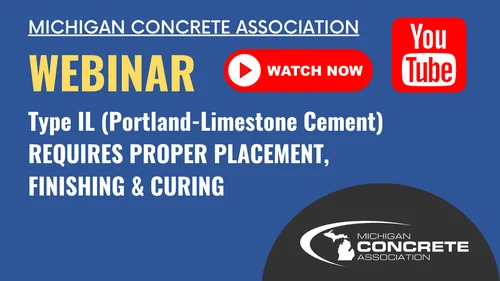Portland Limestone Cement
- Type 1L is often referred to as "portland-limestone cement," or PLC
- Cement companies have formulated Type 1L to perform similar to their Type 1.
- Type 1L allows up to 15% interground limestone, whereas Type 1 has allowed up to 5% for many years now.
- Most Type 1L cements result in an approximate 10% reduction in carbon production vs. the standard Type 1.
- Other owner/engineer specifications should allow both ASTM C595 Type 1L cement and ASTM C150 Type 1.
- Type 1L is more sensitive to poor finishing practices. (See Contractor Tips Below)
OTHER PLC "FACTS"
Portland-limestone cement (PLC), also known as Type 1L, is engineered with a higher limestone content than ordinary portland cement to reduce the carbon footprint of concrete by about 10%. It represents an important step toward sustainability, but it does come with differences in performance that contractors, producers, and finishers need to understand in the field.
Concrete made with PLC meets the same specifications and mix design standards as ordinary portland cement, but crews may notice that it handles differently. Workability, air entrainment, and set times can be more sensitive to temperature and water content. In hot weather, PLC mixes may set faster; in cold weather, they may slow down more than expected. Placement and finishing can feel “stickier” compared to Type I, requiring adjustments in admixture use, timing, and curing practices to achieve consistent results.
Concrete is everywhere. Other than water, it is the most-used material on the planet, accounting for about half of all manmade materials (by mass). Its versatility and economy make it the foundation of modern life—literally. From roads and bridges to foundations, water systems, and high-rise construction, concrete’s role is essential.
Because society produces and places so much concrete each year, even modest changes to formulation dramatically impact the construction industry’s carbon footprint. Replacing higher-carbon ingredients with lower-carbon options is one of the most effective strategies for sustainability. Portland-limestone cement offers a practical pathway for producers, much like fly ash and slag cement have for decades.
When designed thoughtfully, PLC mixes remain compatible with supplementary cementitious materials (SCMs), allowing contractors to leverage fly ash, slag, or silica fume alongside PLC for an even greater reduction in embodied carbon. The key is recognizing that while PLC can reduce environmental impact, it also demands extra attention in the field—from batching to placement to curing—to deliver the quality and durability that owners expect.
FIELD TIPS FOR CONTRACTORS
🛑Curing Best Practices are ESSENTIAL🛑
Start Early: Begin curing immediately after finishing. PLC is more sensitive to drying, so don’t delay.
Moisture Retention: Use curing compounds, wet burlap, or plastic sheeting to keep surfaces damp. Dry surfaces can lead to surface checking and reduced durability.
Extended Duration: Maintain curing for at least the full recommended period (often 7 days). PLC may need longer moisture retention than Type I to achieve comparable performance.
🌡️Temperature Protection:
In hot weather ☀️: Prevent rapid evaporation with fog misting, evaporation retarders, or sunshades.
In cold weather ❄️: Insulate placements with blankets or heated enclosures. Avoid early form removal.
Edge & Surface Care: Pay special attention to exposed edges, which dry out fastest and are prone to scaling or crazing.
💧Evaporation Retarders: Apply a spray-on evaporation retarder if wind, heat, or low humidity could cause crusting before final finishing.
🛑Avoid Overworking: PLC mixes can feel stickier — minimize excessive troweling that can seal in water or cause surface defects.
✨Finishing Aids help control surface moisture loss during finishing, reducing crusting, stickiness, and premature drying that can lead to defects.
⏳Finishing Timing:
In hot conditions: Be ready to finish sooner — PLC may set up faster.
In cold conditions: Expect slower set — finishing aids (like accelerators or heaters) may help keep things on schedule.
Clean Tools Often: PLC pastes can build up on trowels and screeds more than Type I. Keep tools wiped down for smoother finishing.
Compatibility Check: Make sure any evaporation retarders or finishing aids are tested with your supplier’s PLC mix design. Some products perform differently depending on admixtures.
👉BOTTOM LINE: Think proactive moisture control and smart finishing aids. PLC will reward crews that cure early, cure long, and use evaporation control wisely.
ACCELERATED EARLY STRENGTH GAIN
Almost anywhere you use ordinary portland cement, you can use PLC instead. In the U.S., PLCs have an established track record for transportation infrastructure. Many states have been placing PLC concrete pavements for more than a decade – with good results. From highways to driveways, PLC performs just as well in heavy-duty pavements as it does for residential flatwork. And it’s appropriate for bridge applications, too, from top to bottom, everything from the deck down to the foundation, even including geotechnical work. For buildings, PLC concrete is a natural fit for structural members of any type or size, and it’s also great for exterior finishes and hardscaping. Architects and other designers who are tasked with meeting goals put forth by green rating systems or codes will find PLC an especially useful approach to help them achieve a lower carbon footprint for any project.
EASY TO USE
To help with the transition to more environmentally friendly concrete, cement manufacturers understand that the switch to PLC must be simple. By optimizing PLCs, they have made it easy for specifiers, producers, and installers to use them. PLC can be swapped in for portland cement at a 1:1 replacement level. This is a big help to ready-mix producers, who can continue operations using their well-established systems with a minimal amount of disruption. In most cases, all that is needed for maintaining fresh concrete behavior is the typical tweaking of proportions or admixtures, similar to changing from one source of cement to another. Anyone who knows how to work with cement and concrete knows how to work with PLC concrete.
